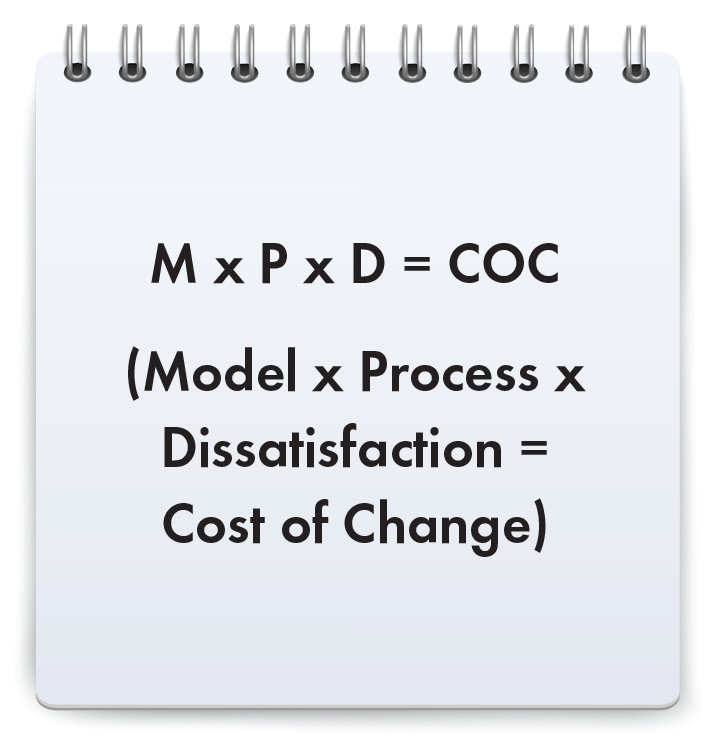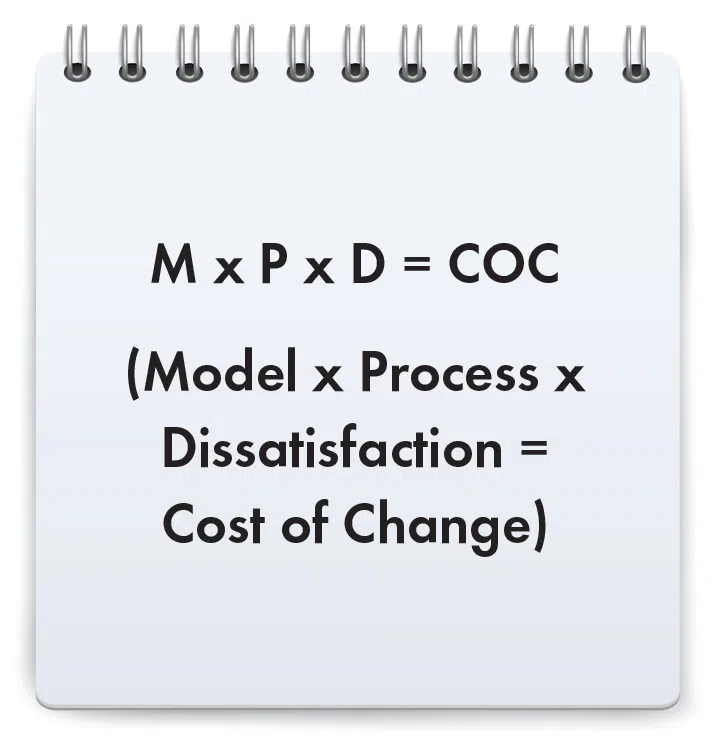Change. We hear about it all the time. What exactly is it? We can define change as moving from a present state of affairs to a future state of affairs.
Normally, when a leader in an organization decides upon a change, they have a vision; they think the change will be good, and that things will be better as a result. So they ask for — and expect — all co-workers who will be affected to cooperate and implement the changes.
Oftentimes, what they fail to do is take the time to carefully and deliberately describe what the finished product will look like — or in other words, to “transfer” the vision. And that’s exactly what must be done in the first place — explain the final product so everyone will clearly understand it.
A Formula for Organizational Change
Implementing and managing change is difficult. It’s been over 20 years since I attended Harvard Business School’s Managing Organizational Effectiveness program and, frankly, I’ve forgotten much of what I learned there, which wasn’t very practical for building and managing an HVACR business. However, I did come away with a technique on how to manage change within an organization that works extremely well.
It involves the following formula:
M x P x D = COC
(Model x Process x Dissatisfaction =
Cost of Change)

In the formula, the first step (the M — for Model) requires the leader to explain what the change will result in, not how the change will be accomplished.
The leader’s “vision” is translated to the company’s “model.”
Gaining Employees’ Trust
Next, the leader must determine how the change will be implemented. How will the company get from the present state of affairs to a future state of affairs? It’s usually best to involve co-workers here. Whenever you encourage co-workers to think, they become involved. As a result of being involved, they will become committed. This is a good leadership principle: thinking leads to involvement, involvement leads to commitment.
Once all the activities have been carefully thought out and determined, you have the formula’s P — for Process. The “process” must be documented and should have setpoints and timelines identifying the steps for exactly what will be done, who will do it, and when it will be done.
That leaves us with the D — for Dissatisfaction.
Here is why dissatisfaction is an important part of the formula: It could very well be that the only person dissatisfied with the present state of affairs is the boss or leader. Hence, you have a normal resistance to change among the co-workers. If your co-workers are wondering what’s wrong with the way things are, you must find a way to create a feeling of dissatisfaction in their minds.
This is often the hardest element of the formula. If you are trying to implement a change that will make things better for both your company and your customers, I’m sure it would also make things better for your co-workers. If they are convinced that the implementation of the “model,” carefully taken care of by the “process,” will result in a better and more rewarding environment for them, they will automatically begin to develop dissatisfaction with the present state of affairs.
What about the other side of the formula? The COC, or Cost of Change?
The more carefully the M x P x D aspects are planned and implemented, the lower the COC.
For example, say the M x P x D side of the formula is not carefully thought out. Just three of the expensive consequences of the COC could be:
- A low level of co-worker morale, resulting in a loss of productivity
- Co-worker turnover
- An inordinate amount of time and energy wasted in trying to get the change in place.
I have coached companies on this managing change technique while they were converting from a time-and-material method of handling demand service, over to a flat rate method. In every instance, we were able to build a feeling of strong dissatisfaction in the service technicians’ minds with the current method, which led them to cooperate extremely well while we implemented the flat rate method. The technicians learned that their jobs would be easier and more rewarding with:
- Less math
- Customers not timing them and counting how often they went to the truck for parts and materials, practically eliminating any customer confrontations
- More service agreement sales as a result of the structure of the flat rate manual.
I have also successfully used this technique while converting software operating systems, which is no easy task under the best of circumstances. This change works out best when you involve the effected coworkers in the process by determining what reports could be generated by the new system to make their jobs easier.
The next time you get ready to make a change within your company, try the managing change technique: M x P x D = COC. You’ll be pleased with the results.
Ron Smith is a well-known authority in the HVACR business with more than 50 years of experience as a contractor franchisor consolidator and consultant. He is the author of HVAC Spells Wealth More and New HVAC Spells Wealth and HVAC Light Commercial Service Agreements.Contact Ron at 615-791-8474 or visit ronsmithhvac.com




.webp)
